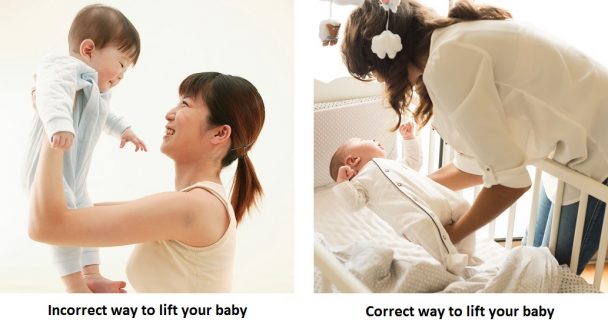
4 Tips for Preventing Mommy’s Thumb Pain
Leave a CommentAs Mother’s Day approaches, we extend a big thanks to all mothers. Many of these mothers have overcome sleepless nights, chronic exhaustion, worry, heartbreak when a child is sick or ill, or endless chauffeur and carpool duties – all while trying to raise healthy, well-adjusted and kind children.
Mothers often fill many roles including nurse, seamstress, teacher, housekeeper, interior designer, family accountant, facilities director, life coach, groundskeeper and event planner. Of course there’s also the thankless role of head chef, which requires one to plan and cook healthy meals for small children who oftentimes don’t even want to eat the food that has been prepared! While a mother’s touch is just what a child needs, it’s no surprise when a mom, who is not just lifting a newborn, but possibly several other toddlers, car seats, diaper bags, dishes, bottles, and laundry baskets full of tiny clothes, begins to experience some wrist and thumb pain. Moms literally have their hands full!
This repetitive use of the upper extremities when lifting, nursing, changing diapers on a squirmy kiddo, and all those other tasks required of a mom, can start to take a toll, causing a condition commonly referred to as “Mommy Thumb” or if you want to be technical, deQuervain’s Tenosynovitis. This condition causes swelling in the tendons on the thumb side of the wrist, causing pain with movement, grasping or pinching. In modern times, cell phone use including scrolling, texting and swiping can cause further irritation. This condition was first described over 100 years ago in a washerwoman, by Fritz deQuervain. Women would experience pain in the base of their thumbs and wrists, after wringing out wet clothes and mechanically washing clothing on a washboard all day long. Luckily those days are over thanks to washing machines!
Whether you are a mom or not, if you start to feel pain, swelling, or tenderness on the thumb side of your wrist when you perform gripping or lifting your child – or if you want to try to prevent having that pain – here are a few suggestions from Athletico’s hand therapists:
- Your wrist and thumb really need some rest, which is often easier said than done for a new mom or if you have several children. Try to recruit some help from your partner, family or older children for heavier tasks. Avoid tasks that increase pain and use your unaffected hand for activities such as brushing your teeth, reaching for a coffee cup and when eating to take some stress off of your injured hand. Limit smartphone use and consider using other fingers or your unaffected hand when using your phone. You can also consider buying frozen vegetables or pre-cut items to decrease the load on your hands.
- Avoid lifting your baby (or other children) with your thumbs and index fingers in an “L” position under their arms, where the fingers are placed on their back and thumbs on the child’s chest. This puts extra stress on the tendons from the thumb as they pass over the back of the wrist. Instead, get as close as you can your child, tighten your abdominal muscles, and lift your baby by sliding one hand under their head and upper back and the other under their bottom. Bring your child close to your chest and use your forearms to support their weight. This technique will distribute the pressure throughout your hand and forearms, taking the pressure off of your thumbs.
- Avoid holding and nursing your infant the same way throughout the day. Some possible alternate holds are the football hold, front facing hold and straddle hold. Consider using a nursing pillow or baby carrier to free your hands altogether and allow your back to do the work instead of your arms and hands.
- Apply ice or a bag of frozen vegetables to the base of you thumb and wrist several times during the day to decrease the inflammation, possibly when your children are napping.
Moms: Take Care of Yourself
If symptoms persist, you should talk with your OB/GYN or your primary care physician. Your physician could prescribe an anti-inflammatory that is safe for you and your baby if you are nursing. Physical and Occupational Therapy can also help! An Athletico hand therapist can give you a stretching program and tailored treatment regimen. They may also fabricate an orthosis to allow your thumb and wrist to rest. This will immobilize the thumb, but allow you to use your hand while reducing the swelling of the tendons to decrease discomfort. If used early and consistently, this will likely decrease your pain in a couple of weeks.
Find a Hand Therapist Near You
The Athletico blog is an educational resource written by Athletico employees. Athletico bloggers are licensed professionals who abide by the code of ethics outlined by their respective professional associations. The content published in blog posts represents the opinion of the individual author based on their expertise and experience. The content provided in this blog is for informational purposes only, does not constitute medical advice and should not be relied on for making personal health decisions.
References:
1. Meals, R., (2008) The Hand Owner’s Manual p.99-101.
2. Amanda Barrell, (2018) What is DeQuervain’s tenosynovitis? Retrieved from https://www.medicalnewstoday.com/articles/320914.php
3. Dashiell, A., & Anderson Lucia, C., Mother’s Thumb: How to Ease Wrist Pain After Pregnancy. Retrieved from https://www.parents.com/baby/new-parent/motherhood/mommy-thumb-5-ways-to-ease-the-pain/
4. van der Walt, R. (2016) How to Deal with Mommy Thumb. Retrieved from https://www.mother.ly/lifestyle/mommy-thumb
5. Jagroo, D., Mommy Thumb: Is this normal? Retrieved from https://beyondmom.com/mommy-thumb-normal/

